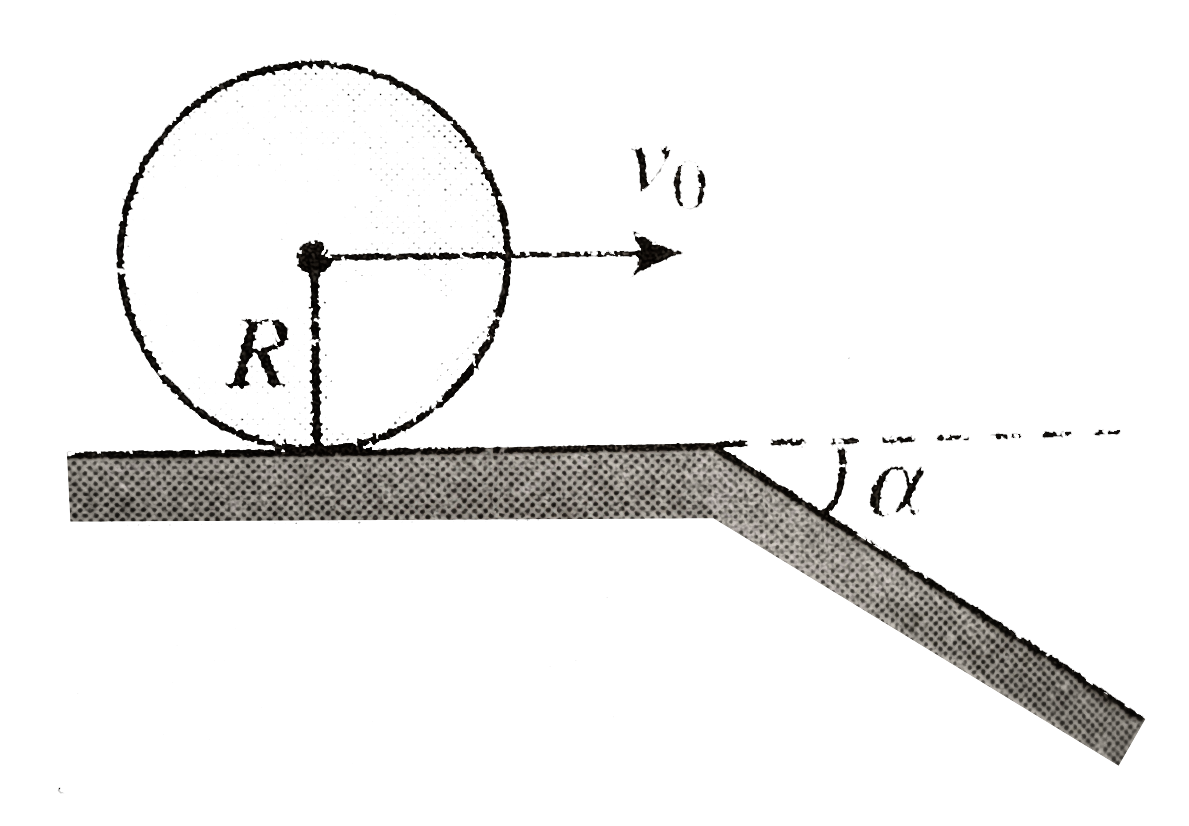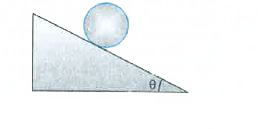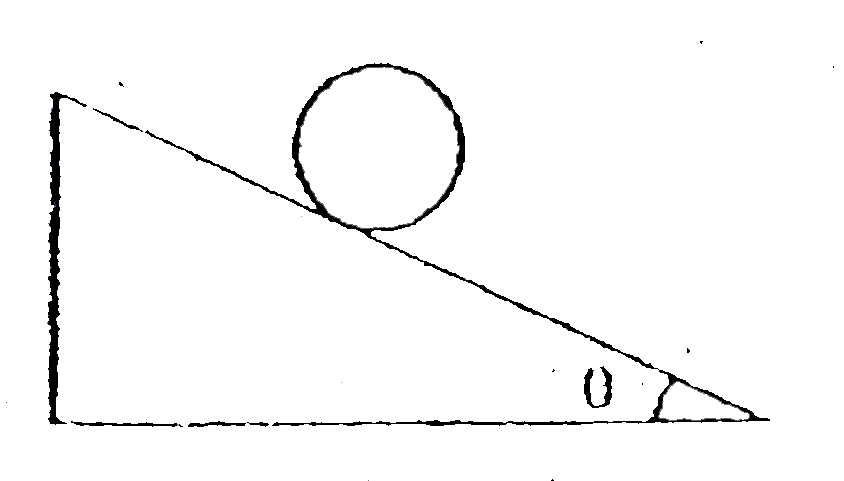A uniform solid cylinder of radius R=15cm rolls over a horizontal plane passing into an inclined plane forming an angle α=30∘ with the horizontal(figure). Find the maximum value of the velocity v0 which still permits the cylinder to roll onto the inclined plane section without a jump. The sliding is assumed to be absent.

Since the cylinder moves without sliding, the centre of the cylinder rotates about the point O, while passing through the common edge of the planes. In other words, the point O becomes the foot of the instantaneous axis of rotation of the cylinder.
It at any instant during this motion the velocity of the C.M. is v1 when the angle (shown in the figure) is β, we have
mv21R=mgcosβ−N,
where N is the normal reaction of the edge
or, v21=gRcosβ−NRm (1)
From the energy conservation law,
12I0v21R2−12I0v20R2=mgR(1−cosβ)
But I0=mR22+mR2=32mR2,
(from the parallel axis theorem)
Thus, v21=v20+43gR(1−cosβ) (2)
From (1) and (2)
v20=gR3(7cosβ−4)−NRm
The angle β in this equation is clearly smaller than or equal to α so putting β=α we get
v20=gR3(7cosα−4)−N0RM
where N0 is the corresponding reaction. Note that N≥N0. No jumping occurs during this turning if N0>0. Hence, v0 must be less than
vmax=√gR3(7cosα−4)

Topper's Solved these Questions
- PHYSICAL FUNDAMENTALS OF MECHANICSBook:IE IRODOV, LA SENA & SS KROTOVChapter:PHYSICAL FUNDAMENTALS OF MECHANICSExercise:Elastic Deformation Of Asolid Body
Explore 25 Videos
- PHYSICAL FUNDAMENTALS OF MECHANICSBook:IE IRODOV, LA SENA & SS KROTOVChapter:PHYSICAL FUNDAMENTALS OF MECHANICSExercise:Hydrodynamics
Explore 25 Videos
- PHYSICAL FUNDAMENTALS OF MECHANICSBook:IE IRODOV, LA SENA & SS KROTOVChapter:PHYSICAL FUNDAMENTALS OF MECHANICSExercise:Universal Gravitation
Explore 34 Videos
- OSCILLATIONS AND WAVESBook:IE IRODOV, LA SENA & SS KROTOVChapter:OSCILLATIONS AND WAVESExercise:Electromagnetic Waves, Radiation
Explore 36 Videos
- THERMODYNAMICS AND MOLECULAR PHYSICSBook:IE IRODOV, LA SENA & SS KROTOVChapter:THERMODYNAMICS AND MOLECULAR PHYSICSExercise:Transport Phenomena
Explore 38 Videos
Similar Questions
A uniform solid cylinder of radius R=15cm rolls over a horizontal plane passing into an inclined plane forming an angle α=30∘ with the horizontal. Find the maximum value of the velocity v0 which still permits the cylinder to roll on the inclined plane section without a jump. (The sliding is assumed to be absent).

View SolutionA uniform solid cylinder of radius R=20cm rolls over a horizontal plane and passes on to an inclined plane meeting the horizontal plane at angle α=30∘ with the horizontal. Find the maximum value of velocity v0 which still permits the cylinder to roll into the inclined plane without a jump. Assume sliding to be absent.
View Solution
Knowledge Check
A solid cylinder of mass M and radius R rolls without slipping down an inclined plane making an angle 6 with the horizontal. Then its acceleration is.
A√34ghB√43ghC√4ghD√2ghA solid cylinder of mass m rolls without slipping down an inclined plane making an angle θ with the horizontal. The frictional force between the cylinder and the incline is
AmgsinθBmgsinθ3CmgcosθD2mgsinθ3A solid cylinder is rolling down the inclined plane without slipping. Which of the following isare correct?
 AThe friction force is dissipativeBThe friction force is necessarily changingCThe friction force will aid rotation but hinder translationDThe friction force is reduced, if ~theta~ reduced
AThe friction force is dissipativeBThe friction force is necessarily changingCThe friction force will aid rotation but hinder translationDThe friction force is reduced, if ~theta~ reduced
A ball falls freely form a height onto and smooth inclined plane forming an angle a with the horizontal. Find the ratio of the distance between the points at which the jumping ball strikes the inclined plane. Assume the impacts to be elastic.
View SolutionA solid cylinder of mass 8 kg and radius 50 cm is rolling down a plane inclined at an angle of 30∘ with the horizontal. force of friction on the cylinder is?
View SolutionA solid cylinder of mass 8 kg and radius 50 cm is rolling down a plane inclined at an angle of 30∘ with the horizontal. The minimum value of coefficient of friction so that cylinder does not slip while rolling down the plane.
View SolutionA solid cylinder is rolling down the inclined plane without slipping. Which of the following is correct?

View SolutionA uniform sphere of mass m and radius r rolls without slipping down a inclined plane, inclined at an angle 45∘ to the horizontal . Find the magnitude of frictional coefficient at which slipping is absent :
View Solution

